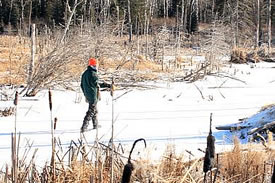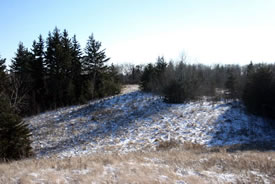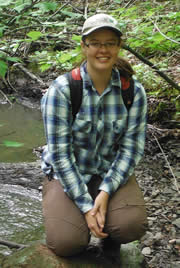My favourite day in the field

Winter field trip, Elk Glen, MB (Photo by NCC)
As a biologist with the Nature Conservancy of Canada (NCC) in Manitoba my field work is typically over once there is snow on the ground and ice on the ponds. Most of the time things need to be green or moving to do my work. However my last day in the field was very white, and I must say it is one of my favourite field days from 2014.
This November NCC staff joined Parks Canada staff for a very successful and informative fire management planning session at our Elk Glen property in the Riding Mountain Natural Area. As I am wont to do, I took advantage of the day in the field to do some multi-tasking. I decided to collect some last-minute info on the fescue prairie in an effort to update our maps and species lists in advance of the development of a management plan for the property.
Now my last-minute, very late-season survey wasn’t the only data we had collected. Throughout the summer I had snuck some impromptu botanizing into my various visits to the property however the bulk of our information came from my colleague Marie Prill, who conducted assessments on the grasslands throughout the property. These assessments are one of the new tools we have recently developed as part of our regional effectiveness monitoring program. This information provides us with not only an important baseline, but also allows us to measure change over time.

Winter at Elk Glen, MB (Photo by NCC)
Back to the awesome day in the field. Why was it awesome? So many reasons! First, I finally found rough fescue (Festuca hallii) on the property. This grass is uncommon in Manitoba, and although the historical extent of fescue prairie in Manitoba is not well understood, we know that only fragments of it remain.
Now I say “I finally found” because technically Marie had already tentatively identified it during her assessments, and a researcher doing a pollination study on the property had also found it...but for me it was a first for that property! Not only did I finally observe it, but I observed it in locations not previously identified, increasing the known extent.
The second reason I had such a good day is also grass-related. I observed three other species uncommon to Manitoba: Porter’s chess (Bromus porteri), Canada mountain-ricegrass (Achnatherum richardsonii) and green needlegrass (Nassella viridula).
Now some people may think, "Ugh grass, boring." So for those who aren’t botanically inclined, I come to reason number three: animal tracks! The fresh, soft snow provided the perfect medium for all sorts of critters to leave behind trails.
I’m no mammal expert so the only ones I recognized right off the bat were the bears and coyotes, but my fellow field staff quickly identified the remaining tracks as belonging to hares, squirrels, a couple little rodents and a mink or other weasel relative.
But to be honest, the real reason I had such a great time is simply because it was Friday and I was outside on gorgeous day. The sun was shining, with no wind or bugs. After a long week in the office it was just the recharge I needed to tackle the mound of paperwork awaiting my return on Monday.


